How to Install Sod Correctly - 5 Tools, 6 Steps, & 7 Tips
It’s not the easiest project you’ll ever try. You’ll sweat, get really dirty and have a tired back when you’re finished. But for a great-looking “instant” lawn, or if you’re redoing some of the landscaping around your yard, you’ll have to lay sod.
To make sure that your time and dollar investment is a success, you need to know more than just “green side up.” But don’t worry. The steps are straightforward and easy to understand and it’s one project that’s doable by even the greenest DIYer.
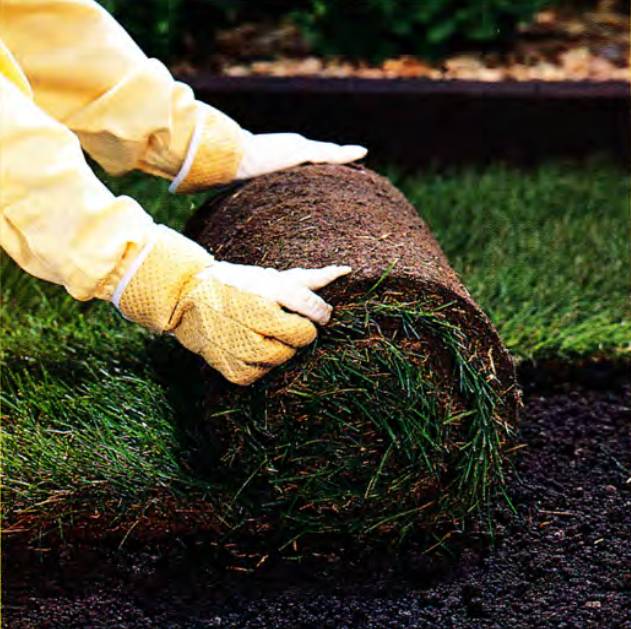
When Is The Best Time Of The Year To Lay Sod?
The two recommended times to lay sod are the early spring or late fall.
Either season allows for strong root growth so they’re firmly established into the soil before the hot summer sun or winter’s icy blast can damage them.
And if the roots have a strong start, you’ll have a great-looking lawn for the future.
How To Test Your Soil pH
If your grass looks like you just finished hosting one of the World Cup Soccer games or it just plain looks sick, the problem may be the dirt under your lawn.
Dig some random soil samples and have them tested for their pH level. The pH determines whether a soil is sweet (alkaline) or sour (acid) and it affects how well grass will grow.
Most county extension services will test soil for a small fee. You can also buy a soil-testing kit at your local hardware store or nursery.
What Does My Soil pH Mean?
The pH level of soil ranges from 0 to 14, with 7 being neutral. Most lawns do best when the pH is between 6.5 and 7.
Here’s how to interpret your pH soil level:
- If the pH level is from 0 to 5, the soil is high in acid.
- If the pH level is 8 or higher, the soil is alkaline.
How To Adjust Your Soil pH
If the pH level is acid, you should add lime to it to reduce its acidity and raise the level closer to 7.
If the pH level is 8 or higher, the soil is alkaline, and you should add dusting sulfur to increase its acidity.
Lime and sulfur are sold at nurseries and garden centers. Have the folks at the nursery help you determine how much lime or sulfur to add.
The amount is determined by the pH level and the square footage you’ll be resodding. The best time to add lime or sulfur is when you’re adding topsoil.
What Tools And Materials Do You Need To Lay Sod?
You probably have most of these items on hand:
- a metal garden rake,
- a utility knife,
- a hammer,
- some heavy work gloves, and
- work boots.
You’ll need to rent a gas-powered, rotary tiller to turn under the old grass and to work the new topsoil and lime or sulfur into the dirt.
You’ll also need to rent a drum roller to flatten or tamp the sod in place once it has been laid.
For materials, you’ll need:
- sod,
- topsoil (not black dirt — there is a difference, so keep reading),
- some starter fertilizer, and
- if your lawn has some hills or slopes that will be resodded, a couple of 1x2s to cut into short stakes to hold the sod on the hill while the roots take hold.
6 Steps To Lay Sod Yourself (With Pictures)
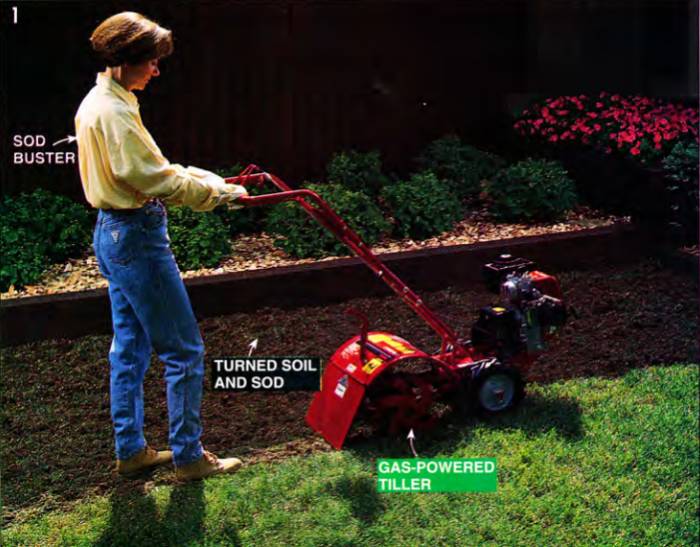
- Turn under the old sod with a gas-powered rotary tiller. Make several passes in a crisscross pattern to chop the old sod and turn over the soil. Once the sod and soil are thoroughly mixed, add the topsoil and nutrients (lime or sulfur) and work them in with the tiller. Keep tilling until the soil is clump-free.
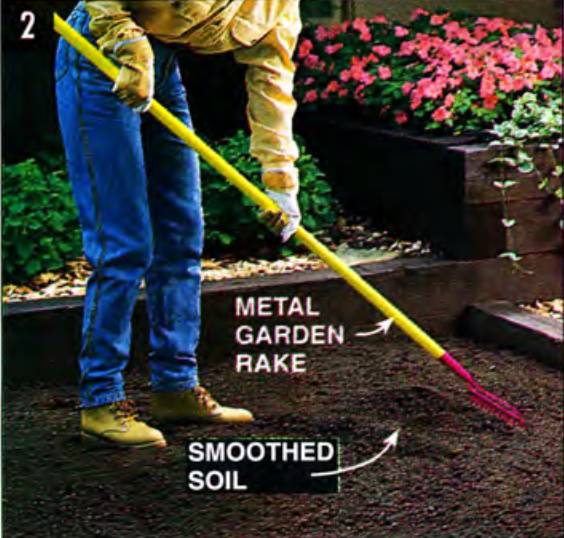
- Smooth the tilled soil with a metal garden rake. You want the soil to be as smooth as possible, so there won't be any lumps or valleys under the new sod. This is the time to change the slope or grade of the landscape if desired. Now spread lawn starter fertilizer on top of the soil to stimulate rapid grass root growth.
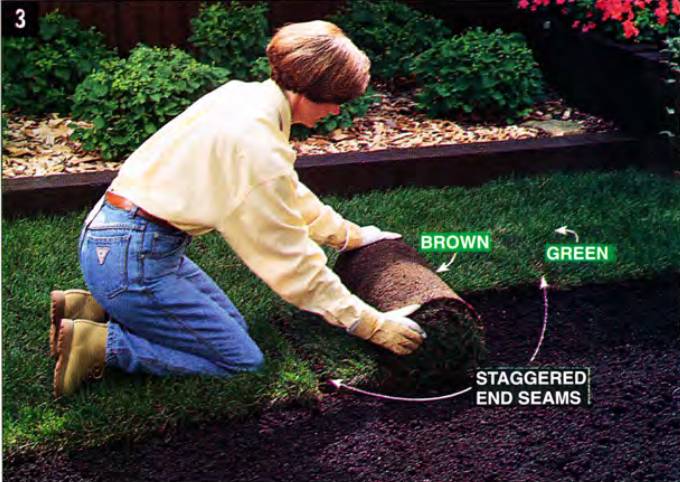
- Lay the new sod in place. Make sure each new roll butts tightly against the neighboring roll to minimize seam lines. Cut some rolls shorter so the ends form a staggered or running-bond pattern, the same pattern you see in a brick or concrete block wall. The staggered end seams also reduce erosion and runoff.

- Cut the sod with a utility knife when patching. You'll need to patch whenever you're working around a driveway, as we are, or sidewalks, trees, and other landscape elements. Lay complete rolls of sod first, then cut smaller pieces to fit.
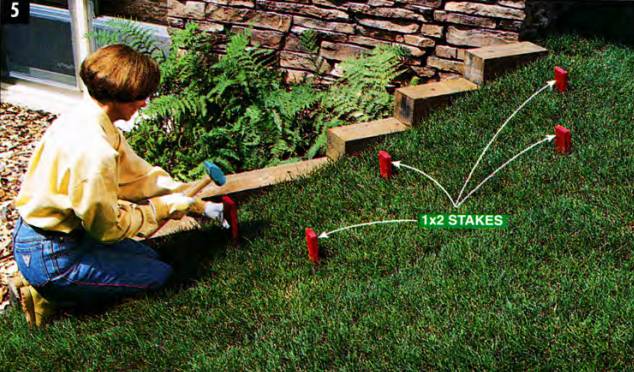
- Drive short (6- to 8-in. long) 1x2 stakes into sod that's on a hill. The stakes hold the sections while the roots establish themselves. Three stakes, one at each end and one in the center, is sufficient. Leave the stakes in place for about two weeks.
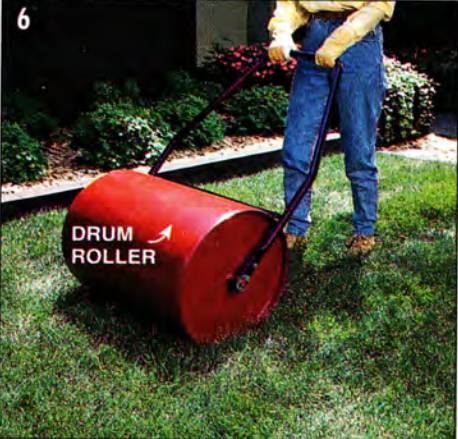
- Roll the new sod with a drum roller the same day that it's laid. The roller can be filled with water; however, the weight of the roller itself (about 25 lbs.) is enough to push the sod's dirt base firmly onto the soil.
7 Tips To Lay Sod
I didn’t show you each step because some are obvious. There are some things, however, that need explanation:
- Before you begin tilling, check with your local utility companies (gas, electric, telephone, and cable TV) for any underground wires, pipes or cables. You won't be tilling deeper than 5 or 6 in., but it's best to be safe. Most utility companies will come out at no charge to mark the locations. Also, note the location of underground pipes and spray heads if your lawn has an in-ground sprinkler system.
- Don't buy the sod too early. Pick it up or have it delivered, depending on how much you need, the day it'll be laid. Rolled-up sod won't last for more than a couple of days. Keep the rolls of unlaid sod wet by misting them with a garden hose, especially if you can't get it all laid in a day.
- Before ordering the sod, check with the supplier to make sure that the sod is freshly cut. Don't accept delivery if it's dry, wilted or yellowed — all signs that the sod is not freshly cut. Go ahead and unroll a couple of rolls and check it out before accepting it. Sod is sold by the roll or "yard" — a roll covers 1 sq. yd.
- Buy topsoil instead of black dirt. Topsoil is pulverized and virtually free of clumps, so you'll spend less time tilling it into the old soil. Black dirt has clumps and takes longer to work in.
- Once the new sod has been laid, water, water, water. You can't overwater new sod. And stay off it for at least three weeks! Many people walk on the sod after a day or two just to see how it's doing. Wrong, wrong, wrong! Walking on it will make deep depressions (even ankle deep!) in the sod. This also weakens the root structure and slows root growth.
- Don't be in a hurry to mow the new grass either. Wait at least four to six weeks before mowing for the first time. When you do cut it, don't cut more than one-third of the grass blade length at a time. Cutting too much at once stresses the grass and roots.
- Photo 5 shows a large area of old sod that had to be removed to even out the grade levels between the lawn and a new driveway. When you're leveling, don't be afraid to cut out existing sod and then remove some of the dirt too. You don't want steep, sudden height changes between surfaces. They're hard to maintain and unsafe to walk on.
The quickest way to cut out old sod is with a rented sod kicker. It looks like an old-fashioned, horse-drawn plow, but it has a sharp metal blade that slices off the sod and about 1 in. of dirt.
And a final bonus tip: be sure to keep the blade sharp. You’ll know when the blade is getting dull because you’ll be kicking harder to make it cut. A few strokes with a metal file on the cutting blade should sharpen it.
It’s not the easiest project you’ll ever try. You’ll sweat, get really dirty and have a tired back when you’re finished. But for a great-looking “instant” lawn, or if you’re redoing some of the landscaping around your yard, you’ll have to lay sod.
To make sure that your time and dollar investment is a success, you need to know more than just “green side up.” But don’t worry. The steps are straightforward and easy to understand and it’s one project that’s doable by even the greenest DIYer.

When Is The Best Time Of The Year To Lay Sod?
The two recommended times to lay sod are the early spring or late fall.
Either season allows for strong root growth so they’re firmly established into the soil before the hot summer sun or winter’s icy blast can damage them.
And if the roots have a strong start, you’ll have a great-looking lawn for the future.
How To Test Your Soil pH
If your grass looks like you just finished hosting one of the World Cup Soccer games or it just plain looks sick, the problem may be the dirt under your lawn.
Dig some random soil samples and have them tested for their pH level. The pH determines whether a soil is sweet (alkaline) or sour (acid) and it affects how well grass will grow.
Most county extension services will test soil for a small fee. You can also buy a soil-testing kit at your local hardware store or nursery.
What Does My Soil pH Mean?
The pH level of soil ranges from 0 to 14, with 7 being neutral. Most lawns do best when the pH is between 6.5 and 7.
Here’s how to interpret your pH soil level:
- If the pH level is from 0 to 5, the soil is high in acid.
- If the pH level is 8 or higher, the soil is alkaline.
How To Adjust Your Soil pH
If the pH level is acid, you should add lime to it to reduce its acidity and raise the level closer to 7.
If the pH level is 8 or higher, the soil is alkaline, and you should add dusting sulfur to increase its acidity.
Lime and sulfur are sold at nurseries and garden centers. Have the folks at the nursery help you determine how much lime or sulfur to add.
The amount is determined by the pH level and the square footage you’ll be resodding. The best time to add lime or sulfur is when you’re adding topsoil.
What Tools And Materials Do You Need To Lay Sod?
You probably have most of these items on hand:
- a metal garden rake,
- a utility knife,
- a hammer,
- some heavy work gloves, and
- work boots.
You’ll need to rent a gas-powered, rotary tiller to turn under the old grass and to work the new topsoil and lime or sulfur into the dirt.
You’ll also need to rent a drum roller to flatten or tamp the sod in place once it has been laid.
For materials, you’ll need:
- sod,
- topsoil (not black dirt — there is a difference, so keep reading),
- some starter fertilizer, and
- if your lawn has some hills or slopes that will be resodded, a couple of 1x2s to cut into short stakes to hold the sod on the hill while the roots take hold.
6 Steps To Lay Sod Yourself (With Pictures)

- Turn under the old sod with a gas-powered rotary tiller. Make several passes in a crisscross pattern to chop the old sod and turn over the soil. Once the sod and soil are thoroughly mixed, add the topsoil and nutrients (lime or sulfur) and work them in with the tiller. Keep tilling until the soil is clump-free.

- Smooth the tilled soil with a metal garden rake. You want the soil to be as smooth as possible, so there won't be any lumps or valleys under the new sod. This is the time to change the slope or grade of the landscape if desired. Now spread lawn starter fertilizer on top of the soil to stimulate rapid grass root growth.

- Lay the new sod in place. Make sure each new roll butts tightly against the neighboring roll to minimize seam lines. Cut some rolls shorter so the ends form a staggered or running-bond pattern, the same pattern you see in a brick or concrete block wall. The staggered end seams also reduce erosion and runoff.

- Cut the sod with a utility knife when patching. You'll need to patch whenever you're working around a driveway, as we are, or sidewalks, trees, and other landscape elements. Lay complete rolls of sod first, then cut smaller pieces to fit.

- Drive short (6- to 8-in. long) 1x2 stakes into sod that's on a hill. The stakes hold the sections while the roots establish themselves. Three stakes, one at each end and one in the center, is sufficient. Leave the stakes in place for about two weeks.

- Roll the new sod with a drum roller the same day that it's laid. The roller can be filled with water; however, the weight of the roller itself (about 25 lbs.) is enough to push the sod's dirt base firmly onto the soil.
7 Tips To Lay Sod
I didn’t show you each step because some are obvious. There are some things, however, that need explanation:
- Before you begin tilling, check with your local utility companies (gas, electric, telephone, and cable TV) for any underground wires, pipes or cables. You won't be tilling deeper than 5 or 6 in., but it's best to be safe. Most utility companies will come out at no charge to mark the locations. Also, note the location of underground pipes and spray heads if your lawn has an in-ground sprinkler system.
- Don't buy the sod too early. Pick it up or have it delivered, depending on how much you need, the day it'll be laid. Rolled-up sod won't last for more than a couple of days. Keep the rolls of unlaid sod wet by misting them with a garden hose, especially if you can't get it all laid in a day.
- Before ordering the sod, check with the supplier to make sure that the sod is freshly cut. Don't accept delivery if it's dry, wilted or yellowed — all signs that the sod is not freshly cut. Go ahead and unroll a couple of rolls and check it out before accepting it. Sod is sold by the roll or "yard" — a roll covers 1 sq. yd.
- Buy topsoil instead of black dirt. Topsoil is pulverized and virtually free of clumps, so you'll spend less time tilling it into the old soil. Black dirt has clumps and takes longer to work in.
- Once the new sod has been laid, water, water, water. You can't overwater new sod. And stay off it for at least three weeks! Many people walk on the sod after a day or two just to see how it's doing. Wrong, wrong, wrong! Walking on it will make deep depressions (even ankle deep!) in the sod. This also weakens the root structure and slows root growth.
- Don't be in a hurry to mow the new grass either. Wait at least four to six weeks before mowing for the first time. When you do cut it, don't cut more than one-third of the grass blade length at a time. Cutting too much at once stresses the grass and roots.
- Photo 5 shows a large area of old sod that had to be removed to even out the grade levels between the lawn and a new driveway. When you're leveling, don't be afraid to cut out existing sod and then remove some of the dirt too. You don't want steep, sudden height changes between surfaces. They're hard to maintain and unsafe to walk on.
The quickest way to cut out old sod is with a rented sod kicker. It looks like an old-fashioned, horse-drawn plow, but it has a sharp metal blade that slices off the sod and about 1 in. of dirt.
And a final bonus tip: be sure to keep the blade sharp. You’ll know when the blade is getting dull because you’ll be kicking harder to make it cut. A few strokes with a metal file on the cutting blade should sharpen it.
